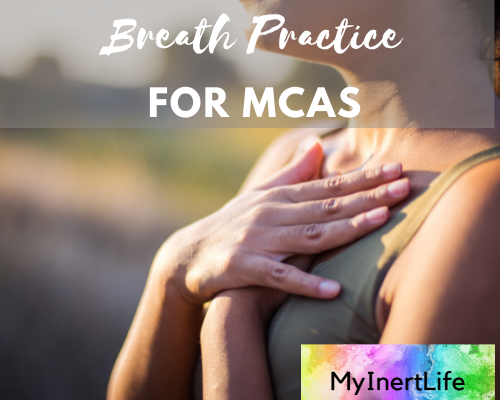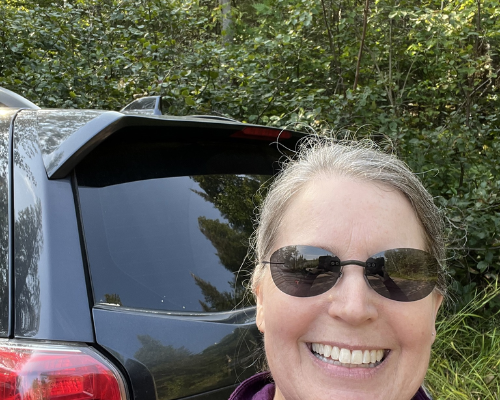This post is Day 12 Backpacking the SHT with MCAS continues my journey on the Superior Hiking Trail with a chronic condition called Mast Cell Activation Syndrome (MCAS).
Table of Contents
Lots of elevation!
Okay, today’s hike wasn’t exactly solo backpacking the SHT with MCAS because my dad joined me!
My dad and I did the 6.4-mile section northbound between Lake County Road 301 Trailhead and Castle Danger Road Trailhead today on the Superior Hiking Trail. It was a beautiful day with sunshine and mid-70-degree weather.
The trail started pretty even and then took us on several creek crossings (the creeks were nearly dry) with lots of rocky climbs and descents. The big river crossing we anticipated at Encampment River turned out to be nearly dry, but apparently, in high water conditions, it is a bit hairy getting across. Because of the lack of rain in recent weeks, the ground is cracked with deep fissures in many areas of the trail, and the areas where it was muddy were few and far between.
We met one thru hiker who had been on the SHT for a week and he hadn’t seen any rain yet. I told him that was amazing compared to the downpours that I experienced in June and July on my section hikes.
It was fun to hike with my dad. My dad’s family has been coming to the North Shore for over 75 years. When I was in high school we took many trips to the north shore as a family and hiked Oberg Mountain, Carleton Peak, and Blueberry Hill. My dad and I ran trails together on Isle Royale and hiked near the Temperance River. It’s been quite a few years since we were out on the trail together, and I enjoyed hearing his stories about canoeing to Hudson Bay when he was a youth before the area was fully mapped. He gave me tips on how to hike most efficiently and showed me which fungi can be used to start a fire.
The final mile of this section featured another big elevation change and my legs were jelly by the time we reached the car.
After the hike, I hopped on my bike and caught up with David and the kids biking back from Stoney Point. We stopped for smoked fish at Russ Kendall’s and at The Great! Lakes Candy Kitchen for a sweet treat.





What is MCAS?
Mast Cell Activation Syndrome (MCAS) is a chronic condition that affects all organ systems. It can cause severe, disabling symptoms every day, including potentially fatal anaphylaxis. MCAS often occurs with other chronic conditions like Ehlers-Danlos Syndrome (EDS) and Postural Orthostatic Tachycardia Syndrome (POTS). Managing MCAS is challenging because many healthcare providers are unaware of it, and diagnostic tests can be unreliable. Treatments involve using antihistamines, mast cell stabilizers, and avoiding triggers. Check out this post on how to manage MCAS.
The bucket theory
The bucket theory simplifies understanding symptom reactions with MCAS. Imagine your body as an empty bucket you don’t want to overflow. Reactions to various stimuli fill the histamine bucket at different rates, forming the total histamine level (how full your bucket is). More histamine means more symptoms. By managing triggers, reducing exposures, and taking medications and supplements, you can control your bucket’s level.
Know your typical symptom progression
Knowing your symptom progression in a symptom flare is the key to developing your rescue plan. This post discusses how to recognize your symptom progression to be prepared to address those symptoms.
Get my free ebook, symptom log, and meal plan!
Want a tool to easily keep track of your symptoms? Sign up for my newsletter and you will receive my free 50-page ebook of lower-histamine, grain-free, sugar-free recipes, my free symptom log, and a free two-week meal plan!
Sign up for the SSP!
The SSP is a listening therapy based on Polyvagal Theory created by Stephen Porges to unlock your ability to think, feel, and connect better through nervous system regulation. You use the SSP via an app on your phone and listen with over-the-ear headphones to specially filtered music that heals the nervous system, specifically the vagus nerve. You subscribe to the app with a provider like me and listen to the specially curated music for 30 minutes each day for a 5-hour cycle. Studies show the SSP has a profound effect on mental health and chronic conditions
You can sign up for the SSP here!
Order my book!
Rocks and Roots chronicles my journey solo backpacking the Superior Hiking Trail and overcoming nervous system dysregulation, gut dysbiosis, and Mast Cell Activation Syndrome symptoms to hike 328 miles successfully.
Check out this powerful frequency device
Healy is an individualized microcurrent device I use to reduce inflammation. Check out this post for more about Healy.
Sign up for a session!
I provide one-on-one in-person and remote chronic illness and caregiver coaching and Sacred Self-Healing Sessions based on the Sacred Self-Healing Method, a proven novel co-creative healing modality detailed in my Books.
Click here for more information.
What do you think?
I’d love to have your reply below!
Disclaimer
The preceding material does not constitute medical advice. This information is for information purposes only and is not intended to be a substitute for professional medical advice, diagnosis, cure or treatment. Always seek advice from your medical doctor.




